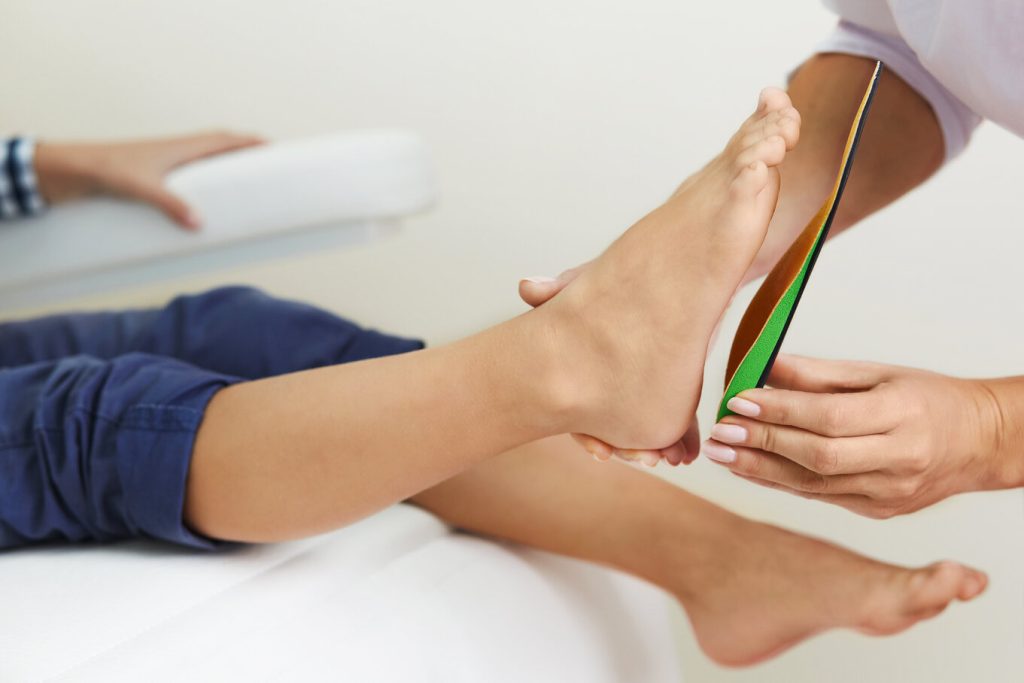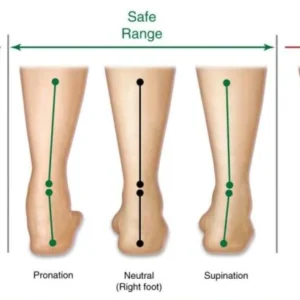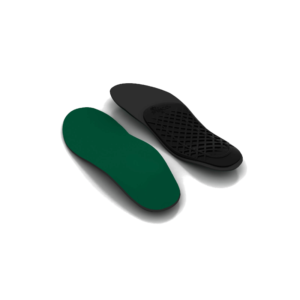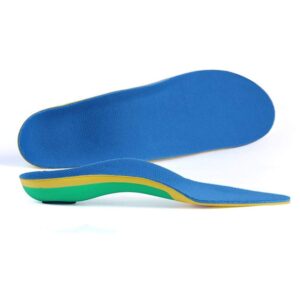Introduction to Foot Comfort and Arch Support
Foot comfort is a fundamental aspect of overall health and well-being, but it’s often overlooked until problems arise. At the core of foot comfort lies the concept of arch support, a critical factor that influences not only the health of your feet but also your posture, gait, and even the alignment of your entire body.
The arches of your feet are natural shock absorbers. They are designed to support your body weight and adapt to different terrains as you walk or run. However, not everyone’s arches provide the right level of support naturally. This is where understanding and addressing arch support becomes crucial.
Inadequate arch support can lead to a myriad of issues. Common problems include foot pain, especially in areas like the heel or ball of the foot, plantar fasciitis, and overpronation, where the feet roll inward excessively when walking. These issues can have a domino effect, potentially leading to knee, hip, and back pain due to the misalignment caused by improper foot support.
Conversely, proper arch support can alleviate existing foot discomfort, prevent potential foot-related problems, and promote a more comfortable and healthy walking experience. It involves using the right footwear, insoles, or orthotics that provide the correct balance of cushioning and support tailored to your unique foot structure.
Whether you’re an athlete, someone who stands for long hours, or simply someone looking for a comfortable daily walk, understanding and applying the principles of arch support is key to maintaining foot health and overall comfort. By nurturing your feet with the right support, you’re setting a strong foundation for your overall physical health and well-being.
Understanding Arch Types and Their Importance
Understanding the different types of foot arches and their importance is essential for ensuring foot comfort and overall bodily health. The human foot typically falls into one of three arch categories: normal (medium), flat, or high. Each type impacts how weight and stress are distributed across your feet and can influence your overall posture and gait.
- Normal Arches: This is the most common arch type, characterized by a well-defined, moderate arch. Feet with normal arches are generally well-equipped to absorb shock and align the body properly. They are usually biomechanically balanced, meaning they’re not overly prone to common foot problems. However, maintaining good foot health is still important, even for those with normal arches.
- Flat Arches (Flat Feet): Flat arches mean there’s little to no visible arch space beneath your inner foot. People with flat feet tend to overpronate, meaning their feet roll inwards excessively when walking or running. This can lead to various issues, such as heel pain, arch pain, plantar fasciitis, and even knee, hip, or back problems due to misalignment. Supportive shoes and orthotics are often recommended to help mitigate these issues.
- High Arches: High arches are characterized by a noticeably high and defined arch. While they can provide excellent shock absorption, high arches don’t always distribute weight evenly, which can lead to excessive pressure on the rearfoot and forefoot. Common issues associated with high arches include underpronation (or supination), ankle instability, and metatarsal pain. Cushioned shoes with arch support can help in providing stability and comfort.
Understanding your arch type is crucial for selecting the right footwear and insoles. Properly supported arches can help prevent discomfort and injury, ensuring a healthier, more comfortable walking experience. In some cases, custom orthotics may be necessary to provide adequate support, especially for those with extreme flatfoot or high-arched feet. Ultimately, recognizing and catering to your specific arch type is a key step in maintaining optimal foot health and overall physical well-being.

Why Arch Type Matters
The significance of understanding your foot’s arch type lies in its direct impact on your overall biomechanics, including how you walk, stand, and absorb impact. Each arch type interacts differently with the ground and influences the alignment and function of your feet, which in turn affects your entire body.
- Alignment and Balance: The arch of your foot is a pivotal element in determining your body’s alignment. A well-supported arch helps maintain the legs and spine in a neutral position, aiding in better balance and posture. Conversely, misaligned arches can lead to imbalances, affecting the knees, hips, and back.
- Shock Absorption: The foot’s arch acts as a natural shock absorber. Normal arches efficiently absorb the impact of each step, reducing stress on the feet and lower limbs. Flat or high arches may not be as effective in this role, potentially leading to discomfort or injury over time.
- Pronation Control: Pronation refers to the natural inward roll of the foot after the heel strikes the ground. The arch type influences the degree of pronation. Normal arches usually mean neutral pronation, while flat feet often lead to overpronation, and high arches to underpronation or supination. Improper pronation can lead to various foot conditions and pain.
- Gait Efficiency: Your arch type affects your gait – the way you walk. A balanced, neutral gait is typically seen in those with normal arches. Flat or high arches can lead to compensatory movements, making your gait less efficient, which can lead to fatigue and increased risk of injury.
- Footwear and Orthotic Needs: Knowing your arch type is critical when choosing the right footwear or orthotics. For flat arches, shoes with motion control and stability are beneficial. For high arches, cushioned shoes with good arch support can be helpful. This tailored approach helps in preventing foot-related problems and enhances comfort.
In summary, the type of arch you have plays a fundamental role in your biomechanics. It influences how you walk, how well your body absorbs shock, and how aligned your body is. Understanding your arch type is crucial for selecting appropriate footwear and orthotics, which can help prevent discomfort and injury, leading to better overall foot and body health.
The Science Behind Arch Support
The science behind arch support delves into understanding how properly supporting the natural arches of the feet can significantly impact not just foot health, but overall bodily function and well-being. This aspect of podiatric science combines biomechanics, anatomy, and kinesiology to explain why arch support is vital.
- Biomechanical Efficiency: The arches of the feet play a crucial role in how we move. They function like springs, absorbing the shock of each step and redistributing body weight. Proper arch support enhances this natural shock-absorbing quality, leading to more efficient and less strenuous movement.
- Stress Distribution: The arch of the foot is key in evenly distributing the stress placed on the feet. Without adequate support, certain areas of the foot, like the heel or ball, can experience excessive pressure, leading to pain and discomfort. Proper arch support ensures a more balanced distribution of weight across the entire foot.
- Prevention of Overpronation and Underpronation: Overpronation (excessive inward rolling of the foot) and underpronation (insufficient inward rolling) are common issues related to improper arch support. These conditions can lead to a cascade of alignment problems affecting the ankles, knees, hips, and lower back. Arch support helps in maintaining proper foot alignment and reducing the risk of these issues.
- Reduction of Foot-Related Conditions: Many common foot conditions, such as plantar fasciitis, heel spurs, and bunions, can be mitigated or prevented with proper arch support. By providing the necessary support, the strain on the muscles, tendons, and ligaments of the foot is reduced, lessening the likelihood of developing these conditions.
- Enhanced Comfort and Endurance: With adequate arch support, feet are less likely to become fatigued, enabling individuals to stand, walk, or run comfortably for longer periods. This is especially important for athletes and individuals whose occupations require prolonged standing or walking.
- Overall Postural Support: The feet are the foundation of the body’s postural alignment. When the arches are properly supported, it promotes better alignment of the ankles, knees, hips, and spine, contributing to improved posture and reduced strain on these areas.
In conclusion, the science behind arch support is rooted in its ability to optimize biomechanical function, distribute stress evenly, prevent misalignments and overuse injuries, and enhance overall comfort and endurance. Understanding and implementing proper arch support can lead to significant improvements in foot health and overall quality of life.

Benefits of Proper Arch Support
Proper arch support offers a range of benefits that extend beyond just foot comfort. These advantages are crucial for overall health and well-being, especially for those who spend a lot of time on their feet or have specific foot conditions.
- Alleviates Pain and Discomfort: One of the most immediate benefits of proper arch support is the reduction in foot pain and discomfort. Conditions like plantar fasciitis, flat feet, or high arches can cause significant discomfort, and supporting the arches properly can alleviate these symptoms.
- Improves Foot Function: Arch support helps in maintaining the natural structure and alignment of the foot. This leads to more efficient foot function, making walking and running more comfortable and less taxing on the feet.
- Enhances Posture and Alignment: The feet are the foundation of your body’s posture. Proper arch support helps align your feet correctly, which in turn can improve overall posture and alignment of the ankles, knees, hips, and spine.
- Reduces Risk of Foot Injuries: By distributing weight evenly across the feet and providing stability, proper arch support can reduce the risk of injuries such as sprains, strains, and stress fractures.
- Decreases Strain on Lower Limb Joints: Adequate arch support helps in reducing the strain on lower limb joints, including the ankles, knees, and hips. This is particularly beneficial for individuals with arthritis or other joint-related conditions.
- Prevents Overpronation/Underpronation: Proper arch support can help in correcting overpronation (excessive rolling inwards of the foot) and underpronation (insufficient rolling inwards), which are common causes of foot and ankle issues.
- Increases Endurance and Performance: For athletes and active individuals, proper arch support can lead to improved athletic performance and endurance. It allows for more efficient movement and reduces fatigue in the feet and legs.
- Facilitates Better Weight Distribution: Good arch support ensures that body weight is evenly distributed across the feet, which is essential for maintaining balance and preventing pressure points.
- Supports Recovery from Foot Surgery or Injury: Individuals recovering from foot surgery or injuries can benefit significantly from arch support, as it helps in maintaining proper foot alignment and reduces stress on the healing area.
- Enhances Comfort for Prolonged Standing or Walking: For people whose jobs involve standing or walking for extended periods, arch support can greatly increase comfort and reduce the likelihood of foot fatigue and pain.
In summary, proper arch support is vital not only for foot health but also for the overall musculoskeletal well-being. It provides a foundation for comfortable, pain-free movement, and contributes positively to postural alignment and bodily function.
Identifying Signs of Poor Arch Support
Identifying signs of poor arch support is crucial for addressing potential foot issues before they escalate. Poor arch support can lead to various discomforts and conditions, affecting not only your feet but also your overall posture and musculoskeletal health. Here are some key indicators to look out for:
- Foot Pain and Discomfort: One of the most obvious signs of poor arch support is persistent pain in the feet, especially in the arch area, heel, or ball of the foot. This pain might be particularly noticeable during or after periods of activity.
- Flat Feet or Fallen Arches: If the arches of your feet appear flattened or less pronounced, this could be a sign of poor arch support. Flat feet can lead to overpronation, which stresses your feet and can cause pain.
- Abnormal Shoe Wear Patterns: Examine the soles of your shoes. Uneven wear patterns, such as excessive wear on the inside or outside of the heel, can indicate poor arch support and improper foot alignment.
- Swelling in the Feet or Ankles: Swelling in these areas, particularly after standing or walking, can be a sign that your arches aren’t properly supported, leading to increased strain and fluid accumulation.
- Knee, Hip, or Back Pain: Poor arch support can affect your entire body’s alignment. Pain in your knees, hips, or lower back can sometimes be attributed to issues in foot alignment and support.
- Difficulty in Walking or Standing: If you find it unusually uncomfortable or tiring to stand or walk for reasonable periods, this might be due to inadequate arch support affecting your foot function and overall balance.
- Bunions or Hammertoes: These deformities can sometimes develop as a result of poor arch support, leading to abnormal pressure distribution and foot mechanics.
- Frequent Ankle Sprains: If you experience recurrent ankle sprains or feel that your ankles are unstable, it could be a result of poor arch support affecting your balance and gait.
- Tired Legs: Experiencing leg fatigue or heaviness, especially after walking or standing, can be a sign that your feet aren’t being properly supported, placing extra strain on your lower limbs.
- Reduced Athletic Performance: Athletes might notice a decrease in performance or an increase in foot-related injuries if their arches aren’t adequately supported.
If you observe any of these signs, it may be advisable to consult a podiatrist or foot health specialist. They can assess your foot type, gait, and footwear to determine if poor arch support is a contributing factor to your discomfort and advise on appropriate corrective measures.

Selecting the Right Footwear for Arch Support
Selecting the right footwear is essential for providing proper arch support, which is crucial for foot health and overall comfort. Whether you’re dealing with specific foot conditions or just seeking to enhance daily comfort, the right shoes can make a significant difference. Here’s how to choose footwear that supports your arches effectively:
- Know Your Foot Type: Understanding whether you have flat feet, high arches, or neutral arches is the first step. This knowledge will guide you in choosing shoes that cater to your specific needs.
- Look for Arch Support Features: Shoes that provide good arch support will have a well-defined, firm area in the midsole that matches the shape of your arch. This support should feel comfortable and not overly intrusive.
- Check for Proper Fit: Shoes should fit snugly without squeezing or pressing on any part of the foot. There should be enough room in the toe box, and the heel should not slip out of the shoe when walking.
- Consider Shoe Structure: A good supportive shoe will have a strong, non-flexible sole that doesn’t twist easily. The heel counter (the back part of the shoe that wraps around the heel) should be firm to provide stability.
- Cushioning Matters: Especially for those with high arches, cushioning can help absorb shock and reduce pressure on the feet. Look for shoes with adequate cushioning in the heel and forefoot.
- Specialized Shoes for Flat Feet: If you have flat feet or overpronate, look for shoes categorized as ‘stability’ or ‘motion control’ to help align your feet correctly as you walk.
- High Arch Considerations: For high arches, shoes with a softer midsole and more flexibility can help distribute pressure more evenly across the foot.
- Test Walk Before Buying: Always try on shoes and take a walk around the store to ensure they feel comfortable and supportive. Pay attention to any areas of discomfort or lack of support.
- Replace Footwear Regularly: Worn-out shoes can lose their supportive qualities. Regularly check your shoes for signs of wear and replace them as needed.
- Orthotics and Insoles: Sometimes, the best way to get proper arch support is by using orthotics or insoles. These can be bought over the counter or custom-made for a perfect fit to your feet.
Remember, the right shoes for someone else may not be the right shoes for you. It’s important to consider your individual needs, lifestyle, and the specific demands of your feet when selecting footwear. If in doubt, seeking advice from a foot health professional can be very helpful in making the right choice.
Incorporating Insoles and Orthotics
Incorporating insoles and orthotics into your footwear routine can significantly enhance foot comfort and support, especially for those with specific foot conditions or who require additional arch support. Here’s a guide on how to effectively use insoles and orthotics:
- Understand the Difference Between Insoles and Orthotics:
- Insoles: These are cushioned inserts that can be placed inside shoes to provide extra comfort and support. They are available over the counter and can be used for general cushioning or arch support.
- Orthotics: These are custom-made devices designed to support and comfort your feet. Prescribed by a podiatrist, orthotics are tailored to address specific foot issues such as severe flat feet, high arches, plantar fasciitis, or other biomechanical problems.
- Identify Your Needs:
- Assess your foot type and any existing conditions. Do you have flat feet, high arches, or specific foot pain? Understanding your specific needs helps in choosing the right insoles or orthotics.
- Selecting the Right Insoles:
- Look for insoles that match your arch type and provide the necessary support. There are insoles designed specifically for flat feet, high arches, or neutral arches.
- Consider the material. Memory foam, gel, and cork are popular choices, each offering different levels of support and cushioning.
- Getting Custom Orthotics:
- Consult with a podiatrist or foot specialist to get fitted for custom orthotics. They will take into account your foot structure, gait, and any specific issues you have.
- Custom orthotics are made from a mold of your feet, ensuring a perfect fit and targeted support.
- Adjusting to Insoles and Orthotics:
- Give yourself time to adjust. Start by wearing them for a few hours a day and gradually increase the duration.
- It’s normal to feel a bit of discomfort initially as your feet and body adjust to the new support.
- Use in Appropriate Footwear:
- Ensure your shoes have enough room to accommodate the insoles or orthotics without causing tightness or discomfort.
- Some orthotics are designed to work with specific types of footwear, so it’s important to follow any recommendations given by your specialist.
- Care and Maintenance:
- Keep your insoles and orthotics clean and dry. Many insoles are washable, but check the manufacturer’s instructions.
- Regularly check for signs of wear and replace as necessary. Over time, insoles and orthotics can lose their effectiveness.
- Monitor Your Progress:
- Pay attention to how your feet feel. Proper insoles or orthotics should alleviate pain and discomfort, not cause it.
- Follow up with your podiatrist if you have any concerns or if your symptoms don’t improve.
Incorporating insoles or orthotics can be a game-changer for foot comfort and health. They provide the tailored support that regular shoes might lack, addressing specific foot issues and improving overall foot function.

Exercises for Strengthening Foot Arches
Strengthening your foot arches is important for overall foot health, and there are several exercises that can help improve the strength and flexibility of these structures. Here are some effective exercises for strengthening your foot arches:
- Toe Curls:
- Sit with your feet flat on the floor.
- Curl your toes inward as if trying to grab something with them.
- Hold for a few seconds, then release.
- Repeat 10-15 times.
- Heel Raises:
- Stand with your feet shoulder-width apart.
- Slowly raise your heels, so you’re standing on your toes.
- Hold for a few seconds, then lower back down.
- Do 10-15 repetitions.
- Arch Lifts:
- Stand with your feet flat on the ground.
- Keep your toes flat on the ground and try to raise the arch of your foot while keeping your heel down.
- Hold for a few seconds, then relax.
- Repeat 10-15 times on each foot.
- Towel Scrunches:
- Place a small towel on the floor and sit with your feet extended over it.
- Use your toes to scrunch the towel towards you, then push it away.
- Repeat for about a minute.
- Toe Spreads:
- Sit or stand with your feet flat.
- Spread your toes as wide as you can, then relax them.
- Repeat 10-15 times.
- Marble Pickups:
- Place a few marbles on the floor.
- Using just your toes, pick up one marble at a time and place it into a bowl.
- Repeat until you have moved all the marbles.
- Calf Raises and Stretches:
- Stand facing a wall with your hands at eye level.
- Place one foot behind the other.
- Keep your back leg straight and heel on the floor, and bend your front leg.
- Hold the stretch for 15-30 seconds, then switch legs.
- Also, perform calf raises by lifting your heels off the floor while standing.
- Walking Barefoot on Different Surfaces:
- Walk barefoot on different surfaces like grass, sand, or pebbles. This natural exercise helps strengthen foot muscles and improves arch flexibility.
Remember to perform these exercises regularly for the best results. If you experience any pain or discomfort while doing these exercises, stop and consult with a healthcare professional. Strengthening your arches can not only help with foot comfort but can also improve balance and walking gait.
Tips for Maintaining Healthy Arches
Maintaining healthy foot arches is essential for overall foot health, comfort, and functionality. Here are some tips to help you keep your arches healthy:
- Wear Proper Footwear:
- Choose shoes that provide adequate arch support and fit well. Avoid wearing high heels or flat shoes without support for extended periods.
- If you participate in specific sports or activities, wear shoes designed for those activities to ensure appropriate support.
- Use Orthotics or Insoles:
- Consider using over-the-counter insoles or custom orthotics, especially if you have flat feet, high arches, or other specific foot conditions that require additional support.
- Maintain a Healthy Weight:
- Excess body weight can put extra stress on your feet and arches. Maintaining a healthy weight helps reduce this strain.
- Stretch and Strengthen Your Feet:
- Regularly engage in exercises that strengthen the muscles of your feet and calves. This can help support your arches and improve overall foot health.
- Incorporate stretches for your feet and calves into your daily routine to maintain flexibility.
- Avoid Prolonged Periods of Standing:
- If your job or daily activities involve standing for long periods, try to take breaks and sit down periodically to relieve pressure on your feet.
- Alternate Your Footwear:
- Avoid wearing the same pair of shoes every day. Rotating between different pairs can help reduce wear and tear on specific areas of your feet and provide varying levels of support.
- Practice Good Foot Hygiene:
- Keep your feet clean and dry to prevent infections that can affect foot health.
- Regularly check your feet for any signs of problems, such as changes in shape, color, or sensation.
- Stay Active:
- Engaging in regular physical activity helps improve blood circulation in your feet and overall foot health.
- Pay Attention to Foot Pain:
- Don’t ignore foot pain. If you experience persistent pain in your feet or arches, consult with a healthcare professional or a podiatrist.
- Walk Barefoot When Appropriate:
- Walking barefoot on soft, natural surfaces like grass or sand can help strengthen the muscles in your feet.
By following these tips, you can help ensure that your foot arches remain healthy, which is crucial for maintaining overall foot function and comfort. Remember, if you have concerns about your foot health or arches, it’s always best to seek advice from a healthcare professional.
Arch Support for Athletes
Arch support is particularly crucial for athletes, as they subject their feet to higher levels of stress and impact during training and competition. Proper arch support can not only improve athletic performance but also prevent a range of foot-related injuries. Here are key considerations and tips for athletes regarding arch support:
- Understanding the Importance of Arch Support for Athletes:
- Athletic activities put significant pressure on the feet. Proper arch support helps in distributing this pressure evenly, reducing the risk of injuries and improving efficiency in movement.
- Choose Activity-Specific Footwear:
- Different sports require different types of support. For instance, runners might benefit from shoes with more cushioning and arch support, while soccer players may need cleats with good lateral support.
- Ensure your athletic shoes are specifically designed for the type of activity you engage in.
- Consider Custom Orthotics:
- Athletes with specific foot conditions or unique arch structures may benefit from custom orthotics. These can provide tailored support and improve alignment and comfort.
- A podiatrist or sports medicine specialist can assess your feet and prescribe the right orthotics.
- Replace Athletic Shoes Regularly:
- Athletic shoes lose their cushioning and support over time. Regular replacement is essential to maintain adequate arch support. The general guideline is to replace running shoes every 300 to 500 miles.
- Incorporate Foot Strengthening and Flexibility Exercises:
- Exercises that strengthen the muscles supporting the arches can improve foot stability and prevent injuries.
- Flexibility exercises for the feet and calves can also help in maintaining proper foot mechanics.
- Warm-Up and Cool-Down Properly:
- Include foot-specific stretches and exercises in your warm-up and cool-down routines to prepare your feet for the stress of athletic activities and to aid in recovery afterward.
- Pay Attention to Signs of Stress and Injury:
- Athletes should be vigilant about foot pain or discomfort. Persistent pain could indicate issues like plantar fasciitis, tendonitis, or stress fractures, which may be exacerbated by inadequate arch support.
- Balance Training and Rest:
- Incorporate balance and proprioceptive training to enhance foot stability and reduce the risk of ankle sprains and other injuries.
- Ensure adequate rest and recovery to prevent overuse injuries.
- Stay Hydrated and Maintain a Healthy Diet:
- Proper hydration and nutrition are important for overall muscle and joint health, including the feet.
- Consult with Professionals:
- Regular check-ups with a sports medicine specialist or podiatrist can help ensure that your feet are getting the support they need.
For athletes, effective arch support is not just about comfort; it’s a critical aspect of performance and injury prevention. Paying attention to the specific needs of your feet in relation to your athletic activities is key to maintaining foot health and achieving your best performance.
FAQs
- How do I know if I need more arch support?
- If you experience foot pain, fatigue, or uneven wear on your shoes, you might need more arch support.
- Can arch support help with back pain?
- Yes, proper arch support can help align your posture and reduce back pain.
- Are there any risks to using orthotics?
- While orthotics are generally safe, it’s important to use them correctly and consult a professional if you have specific foot conditions.
- How often should I replace my insoles or orthotics?
- Insoles and orthotics should be replaced every 6-12 months, depending on wear and tear.
- Can children use arch support?
- Yes, proper arch support is important for children, especially as their feet are still developing.



